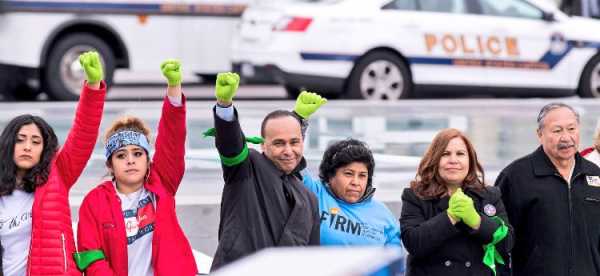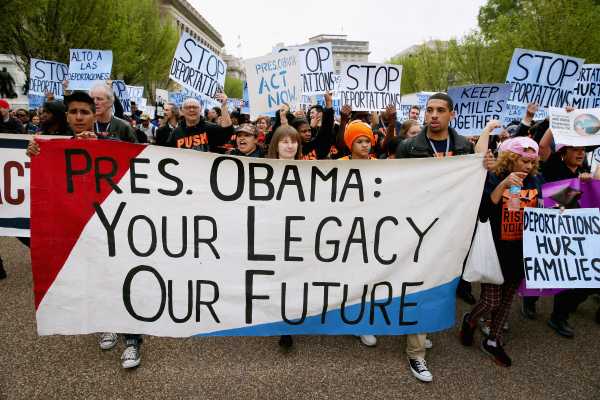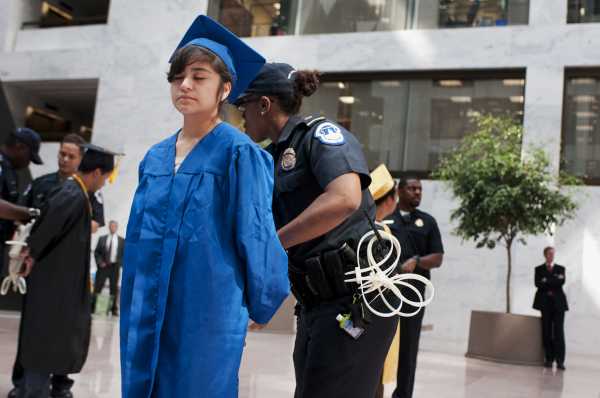
“Abolish ICE” has become a slogan of the progressive wing of the Democratic Party.
Many of the party’s established leaders appear to be caught off guard by the popularity of abolishing ICE (which stands for Immigration and Customs Enforcement) — the agency tasked with enforcing immigration law in the country’s interior, including the arrest, detention, and deportation of unauthorized immigrants who may have lived in the US for years. Former Obama Secretary of Homeland Security Jeh Johnson, for one, has called “abolish ICE” no more realistic than making Mexico pay for the wall.
But it seems more likely than not that the party is going to co-opt the slogan. The 2020 presidential hopefuls playing to the “abolish ICE” crowd aren’t just wild-eyed progressives — they’re operators like Sen. Kirsten Gillibrand (D-NY).
It’s impossible to imagine anything like that happening 10 years ago, when immigration was still an issue that split both parties. Or seven years ago, when immigration activists called a Democratic president the “deporter-in-chief” while Democrats in Congress pushed for legalization of unauthorized immigrants to be paired with robust interior enforcement under “comprehensive immigration reform.” Or even three years ago, when Democrats defended a softened Obama immigration policy as focusing on “felons, not families.”
Part of what has happened is Trump. But part of it is that Democratic elected leaders started to defer to organized immigration activists — and elements of the party’s progressive base started adopting those activists’ concerns as their own.
What we’re seeing is the second phase of a two-part transformation of the party’s politics on immigration. In the first phase, a strategic pivot by labor unions (who embraced immigrants as a potential new base for the labor movement) erased mainstream Democratic opposition to legalization of unauthorized immigrants and tempered concerns about future immigrant flows — bringing the party into lockstep behind the idea of comprehensive immigration reform.
In the second, the party has moved substantially to the left on the issue of immigration enforcement outside of the context of “comprehensive reform” and mass legalization — tentatively under Obama’s Democratic administration, then enthusiastically under Trump’s Republican one.
For Democrats, it’s been a simple calculus. Democrats’ attempts at “tough love” centrism didn’t win them any credit across the aisle, while an increasingly empowered immigrant-rights movement started taking them to task for the adverse consequences of enforcement policies. Democrats have now learned to ignore the critics on the right they couldn’t please, and embrace the critics on the left whom they could.
But just as the Democratic establishment warmed up to its base on immigration enforcement, the “abolish ICE” movement has presented them with a new challenge. Going into the 2018 midterms, Democratic elected leaders are facing renewed tension between the desire to give progressive activists something to mobilize for — and deeply ingrained worries that every step to the left on immigration risks turning off the American people writ large.
The Democratic base moved left on immigration — and the way Democrats related to the base changed, too
It’s easy to forget in the Trump era, but immigration has only been a partisan issue for the past decade or so. Traditionally, it split both parties. Republicans were torn between the racialized populism they’ve leaned into under Trump and the business wing’s desire to increase the immigrant workforce; Democrats were split between progressive and racial-justice activists, and labor — which was worried about immigrants undercutting native workers, and therefore eager to see laws enforced against unauthorized immigrants.
But as American workers became increasingly deunionized in the late 20th century, major labor unions started paying attention to getting more workers unionized. From that perspective, immigrant workers — especially immigrants prone to exploitation because they were unauthorized — were a prime asset.
With labor unions flipping to support unauthorized immigrants, there were no longer institutional interests within the Democratic Party that were interested in taking a more hawkish immigration line. Democrats continued to worry about turning off working-class white voters (the voters who were no longer being represented by unions in the workplace, and who might be more culturally conservative as well) by going too far on immigration. But without any institution promising to turn them out if Democrats did cater to those views, that concern was increasingly abstract.
At the same time, with the election of Barack Obama in 2008, Democrats started realizing that there was a huge upside in turning out (reliably Democratic) black voters at high rates, and in winning big shares of the rapidly growing Latino and Asian-American votes.
On the most basic level, that meant that labor’s institutional pressure on Democrats to moderate on immigration dissipated — just as Latinos, the new demographic force encouraging them to embrace immigrant rights, became more powerful. But the Democrats’ efforts to brand themselves as the party of the demographic future also created a new opportunity for racial-justice advocates to pressure Democrats from the left — challenging them not just to be better than Republicans, but to affirmatively deserve the votes of communities that could just as easily not turn out.
The institutions that Democrats were used to working with to represent identity groups — the NAACP as a mediator for African-Americans, the National Council on La Raza (NCLR, now called UnidosUS) as a mediator for Latinos, the Human Rights Campaign as a mediator for the LGBT community — weren’t used to public confrontations with politicians “on their side.” But the activists were. And over the course of the Obama era, it began to be the activists who set the agenda for the party.
Democrats tried to own the “tough but fair” center on immigration. It didn’t work.
Democrats’ policy priority on immigration, since 2008, has been to allow the millions of unauthorized immigrants who’ve become integrated into American communities (often after a decade or more of living in the United States) to get legal status and ultimately citizenship.
That hasn’t changed. What’s changed has been their perspective on whether amping up immigration enforcement, both near the US border and deeper within the country, helps achieve that goal or hurts it.
“Comprehensive immigration reform” proposals have typically amped up both border and interior enforcement while legalizing most current unauthorized immigrants. To many Democrats — especially Senate Minority Leader Chuck Schumer (D-NY), a leading voice of this strategy — this wasn’t just an acceptable compromise, it was actually ideal. Democrats wanted to end unauthorized immigration; that meant both acknowledging that the population currently settled in the US wasn’t going to leave, and making it as hard as possible for future unauthorized immigrants to come to or work in the US.
When President Obama was elected in 2008, and Democrats had unified control of the federal government, the centrist logic of immigration reform morphed into a political strategy. With Democrats in charge for the first time since 9/11, the party (and the Obama administration) saw a chance to dispel the idea that Democrats were “soft” on security, including on unauthorized immigration. Once Democrats had proven they could be trusted to enforce immigration law, the thinking went, they’d assuage the fears that tended to thwart any “amnesty” pushes — among both the American public, and congressional Republicans.
So the Obama administration continued the expansion of immigration enforcement that began under George W. Bush. It set deportation records; turned a database pilot program into a near-nationwide system to flag unauthorized immigrants checked into jails for Immigration and Customs Enforcement pickup, and touted statistics showing that a majority of deportees were “criminal aliens”; and bragged routinely about how its efforts to deport and prosecute immigrants caught crossing the US/Mexico border were making the border “more secure than ever before.”
It did not work at all.
Immigration hawks pooh-poohed the deportation records. The fact that net unauthorized migration was flat or negative through the early years of the Obama presidency (and net unauthorized migration from Mexico was flat throughout his presidency) got ignored.
The disputes were rooted in a skepticism among immigration hawks that the Obama administration could possibly be “tough” on immigration enforcement. Because they saw that President Obama and his officials ultimately wanted to legalize unauthorized immigrants, that made it impossible to trust the promises that the administration was trying harder than ever to enforce the law now.
Democrats had hoped to build their reputation for responsible immigration enforcement on distinguishing between current unauthorized immigrants and future ones, between “felons” and “families.” But to immigration hawks, those distinctions didn’t naturally exist — and Democrats’ attempts to impose them just looked like so much spin.
Escalating immigration enforcement can’t be all that precisely targeted
The immigration hawks were partly right: On the ground, the distinction between felons and families looked a lot blurrier. What that meant, as often as not, was that the policies the Obama administration championed to keep out or go after “bad” immigrants ended up catching the “good” ones.
The Obama administration’s efforts to target “felons, not families” led it to expand its reliance on local law enforcement. People picked up by local police would be searched in immigration databases; anyone found to be unauthorized could be held for pickup by ICE. That created an incentive for local law-enforcement officers who wanted to go after unauthorized immigrants to focus on apprehending people who might turn out to be unauthorized.
This process cast a much broader net than just “felons.” For unauthorized immigrants, everything from working (with a made-up Social Security Number that turns out to belong to someone else) to driving (in states that don’t permit unauthorized immigrants to get licenses) can be a crime.
More fundamentally, the “criminal alien” label tarred immigrants who were arrested and deported for possessing small amounts of marijuana, or selling phone cards out of their homes, alongside murderers and rapists. Not all Democrats agreed on where the line between “good” and “bad” immigrant ought to be drawn, but it quickly became apparent that it wasn’t congruent with the line between “criminal” and “noncriminal” aliens.
At the same time, the continued buildup of Border Patrol personnel didn’t just affect immigrants trying to come into the US — it affected everyone living within the 100-mile zone under Border Patrol authority. Border communities in New Mexico, Arizona, and Texas complained of the “militarization” of the border and the abuses of Border Patrol agents (even when those abuses were against Mexican citizens on the other side of the fence).
Democrats promised legalization soon, while backing enforcement now. Immigrants and local activists saw that the latter was eating away at the promise of the former. Every person deported was someone who might have been legalized if immigration reform had already passed. Every person picked up by ICE now might be forfeiting their chance to get included in a legalization bill later.

On the ground, the very things that Democrats thought were cost-free political tradeoffs — marginalizing “criminals” because they knew most unauthorized immigrants weren’t public safety threats, increasing enforcement against future immigrants to create political space for current ones — had consequences for the people they were trying to help. And many of the activists were uninterested in cutting Democrats any slack.
Democrats’ immigration position has become dictated by activists in a way Democrats don’t usually go along with
With the Obama administration running the enforcement machine at full blast, establishment Latino and immigration groups tempered their criticism — they needed to save their political capital with the White House to get it to push for a comprehensive immigration reform bill. But that calculus didn’t apply to local and regional groups. And it didn’t apply to new groups that hadn’t been around long enough to be “establishment” — including the groups led by unauthorized immigrants themselves, most of whom were part of a generation of young adults who had been raised in the US without status: the DREAMers.
DREAMers became a prominent voice in the immigrant-rights movement in 2010, when they successfully pressured Senate Majority Leader Harry Reid to bring a bill to legalize them up for a vote after negotiations over comprehensive reform had stalled.
But what distinguished them from the rest of the immigrant-rights movement wasn’t that they were pushing for a DREAM Act rather than comprehensive reform (something that had been done before and that many organizations were willing to try again). It’s that they were willing to use confrontational tactics against Democrats, including sit-ins in Senate offices, to bring attention to their cause.
The willingness to confront Democrats reflected a worldview that didn’t care as much about “reassuring” Republicans about the “rule of law.” Immigration activists chafed at centrist lines about “felons, not families” — not only because they were likely to know people who counted as both under the Obama administration’s enforcement regime, but because they didn’t see an upside to that kind of both-sides rhetoric.
The same pattern ultimately resulted in DACA— the Deferred Action for Childhood Arrivals program — in 2012: DREAMers led a public activist push that often embarrassed Democrats (in this case the White House), but ended up grinding them down. On the local level — often led not by DREAMers, but by immigrant groups like the National Day Laborers Organizing Network — it resulted in the birth of the “sanctuary cities” push to limit local cooperation with ICE, which picked up steam during Obama’s first term. And it resulted in the attempts to expand deferred action for immigrants in 2014 — in which DREAMers played a leading role even though (in many cases) they themselves were no longer at risk of deportation.
Within the immigration-reform debate, DREAMers aren’t an interest group fighting for their own small piece of a much bigger discussion. They’ve functioned as an activist vanguard.

The Democratic shift on immigration helped lead the way for a broader rapprochement with the progressive movement — but its roots were in a simple political truth. Democrats didn’t lose much with centrists or conservatives by abandoning a commitment to “tough but fair” immigration enforcement, because they didn’t get much credit from those groups to begin with. But when they acceded to the demands of critics on the left, they were greeted with enthusiastic Latino support.
Democrats don’t endorse open borders — but they didn’t offer an alternative vision, either
Trump made it easy for Democrats — at least for a while. Not only was the party no longer responsible for immigration enforcement, but they faced a president who’s defined himself by his hardline immigration stance. The Democratic base wanted to see resistance to a president they see as dangerous and possibly illegitimate, and when it came to immigration, Democrats were happy to comply.
But criticizing Trump pushed Democrats further to the left on immigration, period, than they’d previously gone, without explicitly saying as much.
Democrats, in general, now tend to criticize immigration enforcement itself and tend to side with those accused of violating immigration law as a broad matter of principle beyond opposing the particular actions of the administration.
This goes beyond simply representing members of their own communities (and potential electoral constituencies). The activist defense of immigrants caught crossing the border, especially the Central American children and families that now make up a large share of people entering the US without papers, has led Democrats to take a much firmer stance in defending them as humanitarian victims who deserve the chance to seek and receive asylum in the US.
More broadly, Democrats are no longer as willing to attack “illegal immigration” as a fundamental problem anymore.
To some critics on the right, all of this is substantively indistinguishable from a call for open borders — the idea is that it doesn’t matter whether there are theoretical limits on immigration if someone who has broken those laws can’t be deported simply for breaking them.
But even Democrats who affirmatively endorse abolishing ICE, like Alexandria Ocasio-Cortez, the 28-year-old democratic socialist who won New York’s 14th District primary, don’t embrace the idea of open borders per se. They aren’t calling for the abolition of immigration laws, and the changes national Democrats want to make to future immigration aren’t radically different in scope from what many Republicans would favor (though the types of immigrants they’d want to let in are different).
But without a good answer to what they are for instead, Democrats are at risk of being in the same position as immigration doves that they once were as immigration hawks: being attacked from the right for policies they didn’t espouse without getting credit from the left because there were no policy proposals to get credit for.
“Abolish ICE” will either put a spotlight on Democrats’ inconsistencies, or resolve them
To some establishment Democrats like Jeh Johnson and Sen. Ben Cardin (D-MD), the popularity of “abolish ICE” as a meme seems like a rude awakening — a realization that some of their party’s base remains much further left on immigration than they are willing to go.
Democrats who are still invested in the idea of being “a nation of immigrants but also a nation of laws” — who feel it’s important that, even in the minority, they demonstrate sober and responsible governance — continue to accept robust immigration enforcement as necessary. That instinct is going to make it hard for them to get on board with a talking point that sounds as radical as “abolish ICE” does.
But looked at another way, “abolish ICE” is an opportunity to minimize the divisions on immigration within the Democratic Party by focusing on where Democrats agree: in opposition to the enforcement regime practiced by Donald Trump.
Because ICE is distinct from border enforcement (which is handled by Customs and Border Protection, a separate agency) its abolition can be supported both by Democratic Socialists of America activists who genuinely do support open borders, and by mainstream Democrats who simply prefer a return to the pre-2003 status quo.
Because ICE is associated so closely with Trump’s most draconian immigration policies — arrests of domestic violence survivors at courthouses; home raids caught on cell-phone cameras; the detention of immigrant families and separated parents — a Democrat can defend the function of the agency while calling for its current structure to be melted down. Or she can aver that the US government should not be in the business of deporting unauthorized immigrants at all. Or she can simply stay silent on the issue until she’s in a position to vote on specific bills.
No Democrat can do all three of these. But individual Democrats can make different choices while the party stays united under the banner of “abolish ICE.”
This appears to be the calculus that some 2020 hopefuls like Kirsten Gillibrand and Kamala Harris are making — that they can reap the political benefit with their party’s base of endorsing “abolish ICE” now, and trust that in the process of working out the details they can come up with something that offers an olive branch (or at least a fig leaf) to the idea of sober, responsible immigration enforcement.
They might be wrong. But with the president accusing Democrats of supporting MS-13 whether they support the abolition of ICE or not, and with a young Democratic base enthusiastic about “abolish ICE” in a way they were never enthusiastic about comprehensive immigration reform, it’s not hard to understand why they’re trying.
Sourse: vox.com






